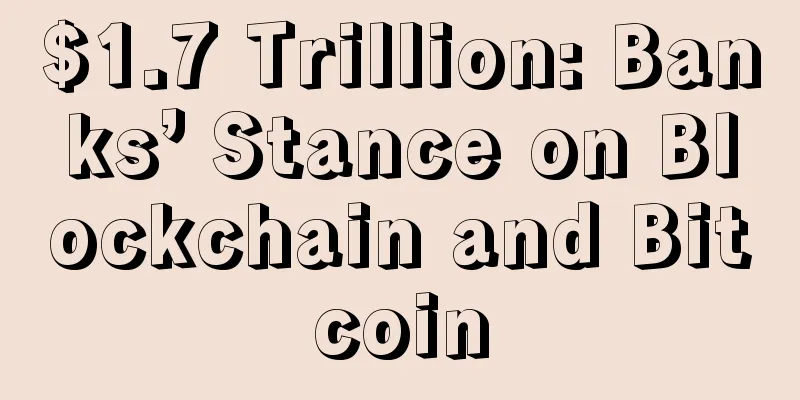$1.7 Trillion: Banks’ Stance on Blockchain and Bitcoin

Translation: Annie_Xu Banks already know that blockchain threatens the core of their economy — customer relationships, where the $1.7 trillion they made from global payments accounted for 40 percent of their annual profits in 2014. The banking industry has always provided three main services - finance, investment and trading. Now they are openly denying Bitcoin and highlighting blockchain or distributed ledger. Do we really need middlemen? Customer relationships are what connect banking institutions and keep profits growing. Do customers still trust or need banks, after taxpayers were hit hard by the 2008 global economic crisis caused by rash banker decisions, which also brought about a decentralized global currency without middlemen and high fees? 2014 was an exceptional year for the global payments industry, which completely exceeded the most optimistic expectations. Revenues doubled from 4% in 2013 to 9% in 2014, profits increased from US$1.5 trillion to US$1.7 trillion, and the proportion of global payments in bank revenues increased from 38% to 40%. Related news reports predict that global payment revenue will maintain an annual growth rate of 6% over the next four years and will exceed US$2 trillion in 2020. Can the bank's competitors win? While banks have been challenged over time, history shows that most competitors fail. Less than 10% of payment startups made it out of the dot-com bubble of 1997-2000, the most notable of which was PayPal. Yet most experts predict this time will be different. Never before in history have banks come up against the world’s largest and most valuable companies, such as Apple, Samsung, Google, Facebook, Microsoft, Amazon and Alibaba. These companies have loyal and active user bases, have penetrated every aspect of their customers' lives, and have large cash reserves, which not only ensures stable income but also makes them a strong opponent for banks. Smartphone with smart payment service Android Pay brought more Android platform users to Google, Alipay brought more e-commerce business to Alibaba, and Apple Pay brought more mobile phone sales to Apple, allowing them to benefit from the existing payment value chain, overturn the existing pricing model, and provide free or significantly lower-than-market-price payment services. In 2017, the global smartphone usage rate will increase to 50%, as more users become accustomed to the various daily services provided by mobile phones. Some users will abandon banking apps and switch to third-party financial service apps. 33% of US millennials aged 15-33 believe banks will no longer be needed in the next five years. Even Apple Pay, Samsung Pay and Alipay offer cheaper transactions, and fees from Visa, American Express and MasterCard cut into retailers’ profits. The biggest threat to bank profits The digital currency Bitcoin is the biggest threat to banks’ payment service revenues, completely eliminating reliance on banks, credit and debit cards, providing secure, global, free and instant payment services. Financial institutions, central banks and payment processors know that blockchain is the biggest technological innovation in centuries, rendering existing systems obsolete. They know that as more people use smartphones and non-bank payment apps, the technology underlying Bitcoin could allow for simpler adoption, and trillions of dollars in annual payment services revenue could disappear entirely. They cannot control the blockchain, and don’t even know how to regulate it, but they know clearly that they can no longer stop its development. Bitcoin and the controllable blockchain Their only option is to ignore it, refute its flaws, and try to deceive mainstream society with the concept of blockchain or distributed ledger, while promoting the benefits of blockchain and controlling it for profit. When you realize that this is working towards $1.7 trillion in annual revenue, it’s understandable why banks are choosing blockchain concepts over Bitcoin. I don’t think the name will have any long-term impact as the currency is still moving inexorably towards mainstream adoption and transaction volumes will soar to all-time highs eight years from now. |
<<: Bitcoin exchange Coin.mx founder extradited to US amid cybercrime charges
>>: US blockchain companies advance licensing options across states
Recommend
How to tell the difference between a woman's sexual desire and her appearance
It is well known that facial features can reveal ...
A major financial shift will allow you to save money without a bank
Peer-to-peer lending, namely Bitcoin and other co...
Judging from the IQ of palmistry, which palmist has the highest IQ?
Judging IQ from palmistry, which palmist has the ...
Analysis of the face of a woman with a high nose bridge who can help her husband
What is the personality of a woman with a high no...
Why are men with narrow eyes more popular with women?
Why are men with narrow eyes more popular with wo...
What kind of face makes women prone to gain weight?
In fact, for women, gaining weight is indeed a ve...
What kind of face is prone to get angry?
People like to get along with optimistic and chee...
Are women with moles on their right ears lucky in helping their husbands? Is it good to have a mole on the right ear?
Moles are not only present at birth. For many of ...
Is it good to have a mole on the forehead? Which part of the forehead is better to have a mole on?
The appearance of the mole on the forehead is gene...
Women with moles on their faces will have unhappy marriages
Generally speaking, moles on the face are not a g...
Men with many crow's feet when they smile, how to analyze people's fortune through facial features
If a person loves to laugh, then crow's feet ...
Analysis of the fate of a woman with a mole on her hairline
Moles can be divided into broad and narrow meaning...
Is it good or bad to have a sunken temple? Analysis of the face reading of a sunken temple
Is it good to have sunken temples? Some people ha...
Cryptocurrency winter continues as Bitcoin miners try to deleverage to avoid liquidity crunch
Cash-strapped bitcoin miners are reducing loan am...
The face of a woman who is shy when holding hands, simple and innocent
If a woman's mind is too complicated, she wil...









